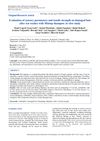Search
for
Sort by
Research
150-180 / 1000+ results
research Evaluation of Sensory Parameters and Tensile Strength on Damaged Hair After Ten Washes With Mintop Shampoo: An In Vitro Study
Mintop shampoo improved hair smoothness, shine, and strength after ten washes.
research Clinical Nutrition Program Improves Sensory Loss in a 60-Year-Old Truck Driver with Anti-MAG Neuropathy
A clinical nutrition program improved sensory and motor function in a 60-year-old with anti-MAG neuropathy.
research Isolation of Sensory Hair Cell Specific Exosomes in Human Perilymph
research Montagna Symposium 2016: The Skin, Our Sensory Organ for Itch, Pain, Touch, and Pleasure
The symposium highlighted the skin's role in sensing itch, pain, touch, and pleasure, and discussed new research and techniques for understanding and treating these sensations.

research Neuro-Inspired Biomimetic Microreactor for Sensory Recovery and Hair Follicle Neogenesis Under Skin Burns
The device helps restore sensation and grow new hair follicles after skin burns.

research Strontium: A Potent and Selective Inhibitor of Sensory Irritation and Topical Anti-inflammatory
Strontium can effectively reduce skin irritation and inflammation.
research Defining the Cellular Environment in the Organ of Corti Following Extensive Hair Cell Loss: A Basis for Future Sensory Cell Replacement in the Cochlea
The conclusion is that genetic differences affect how the cochlea heals after hair cell loss, which may challenge the creation of hearing loss treatments.

research Health Benefits, Antioxidant Activity, and Sensory Attributes of Selected Cold-Pressed Oils
Cold-pressed rapeseed oil is most resistant to oxidation and certain oils may reduce chronic disease risk; consumers like the taste of pumpkin oil best.

research Perspectives of Kennedy's Disease
Kennedy's disease leads to muscle weakness and sensory issues, has no cure but manageable symptoms, and future treatments look promising.

research Development of Gene Therapy for Inner Ear Disease: Using Bilateral Vestibular Hypofunction as a Vehicle for Translational Research
Gene therapy, especially using atoh1, shows promise for creating functional sensory hair cells in the inner ear, but dosing and side effects need to be managed for clinical application.

research Atypical Hippocampal Glutamate Receptor Coupled to Phospholipase D Controlling Stretch-Sensitivity in Primary Mechanosensory Nerve Endings Is Homomeric Purely Metabotropic GluK2
A special receptor in sensory nerve endings helps control how they respond to stretching.

research Finasteride Administration Potentiates the Disruption of Prepulse Inhibition Induced by Forced Swim Stress
Finasteride worsens stress effects on sensory processes, possibly linking to anxiety/depression.

research The Rotterdam Study: 2016 Objectives and Design Update
The Rotterdam Study found risk factors for elderly diseases, links between lifestyle and genetics with health conditions, and aimed to explore new areas like DNA methylation and sensory input effects on brain function.
research Receptor Types in Cat Hairy Skin Supplied by Myelinated Fibers
Cats' hairy skin has different touch receptors connected by myelinated fibers.

research Stem Cell Dynamics in the Hair Follicle Niche
Stem cells in the hair follicle are regulated by their surrounding environment, which is important for hair growth.

research Concise Review: Tissue-Engineered Skin and Nerve Regeneration in Burn Treatment
New methods for skin and nerve regeneration can improve healing and feeling after burns.

research Effect of Topical Application of Raspberry Ketone on Dermal Production of Insulin-Like Growth Factor-I in Mice and on Hair Growth and Skin Elasticity in Humans
Raspberry ketone may help grow hair and improve skin elasticity.

research Dihydrotestosterone Inhibits Hair Growth in Mice by Inhibiting Insulin-Like Growth Factor-I Production in Dermal Papillae
Dihydrotestosterone (DHT) stops hair growth in mice by lowering a growth factor important for hair.

research Sensitive Skin
Sensitive skin often causes discomfort, affects many people, especially women and older adults, and should be managed with careful product selection.

research Responses of Hair Follicle–Associated Structures to Loss of Planar Cell Polarity Signaling
Loss of Fz6 disrupts hair follicle and associated structures' orientation.

research Dietary Isoflavone Increases Insulin-Like Growth Factor-I Production, Thereby Promoting Hair Growth in Mice
Eating isoflavone can help mice grow hair by increasing a growth factor.

research The Hair Follicle: Functions, Self-Renewal, and Alopecic Disorders
Dogs could be good models for studying human hair growth and hair loss.

research The Regeneration of Caudal Epidermal Specializations in Lygodactylus Picturatus Keniensis (Gekkonidae, Lacertilia)
Lizards can regrow their tail scales with the same structure, distribution, and gender-specific features as the original ones, and this unique ability is not seen in adult mammals.

research Assessment of Hair and Scalp Disorders
Hair and scalp disorders significantly affect self-esteem, and using cosmetic products like conditioners and styling aids can improve hair health and appearance.

research Hair Follicles and Their Role in Skin Health
Hair follicles are essential for skin health, aiding in hair growth, wound healing, and immune function.

research Branching of Spiral Ganglion Neurites Induced by Focal Application of Fibroblast Growth Factor-1
FGF-1 causes spiral ganglion neurites to branch more.
research Face Transplantation for Granulomatosis With Polyangiitis (Wegener Granulomatosis)
Face transplant for a severe autoimmune disease patient was successful, improving appearance and function without disease relapse after three years.

research The Pathological Culprit of Neuropathic Skin Pain in Long COVID-19 Patients: A Case Series
Long COVID-19 patients with skin pain might have a nerve condition that responds to a medication called gabapentin.

research Developmental Plasticity of Patterned and Regenerating Oral Organs
Fish teeth and taste bud densities are linked and can change between types due to shared genetic and molecular factors.